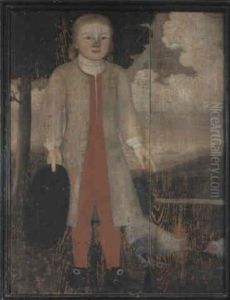Pieter Vanderlyn Paintings
Pieter Vanderlyn was a Dutch-American painter active during the early colonial period in America, born in 1687 and passing away in 1778. While not as widely recognized as some of his contemporaries, Vanderlyn played a significant role in the development of early American art, particularly in the Hudson River Valley area, which became a prominent site for American landscape and portrait painting. His life and work bridged the cultures and artistic traditions of Europe and the burgeoning American colonies, contributing to the evolving American artistic identity.
Vanderlyn's early life and training are not extensively documented, but it is known that he was born in the Netherlands and emigrated to America, settling in the Dutch colonial territories of New York. This background gave him a foundation in the Dutch painting tradition, which he adapted and expanded upon in his American context. Vanderlyn is primarily known for his portraits, which capture the emerging American elite and middle class, and for his landscapes, which reflect an early appreciation of the American wilderness.
Throughout his career, Vanderlyn's work exhibited the influence of European styles, particularly the Dutch Baroque tradition, characterized by its use of light and shadow, as well as a keen attention to detail. However, he also began to develop a distinct style that incorporated elements of the American landscape and character, setting the stage for later American artists who would focus exclusively on American themes.
Despite his contributions to early American art, Vanderlyn's work was somewhat overshadowed by later generations of American artists, such as those associated with the Hudson River School, who gained greater recognition for their depictions of American landscapes. Nevertheless, Vanderlyn's paintings remain important for their historical value and for their role in the early development of an American artistic tradition.
Pieter Vanderlyn's legacy is preserved in several collections and museums, where his portraits and landscapes offer a window into the colonial American experience, reflecting the cultural and environmental context of his time. His work not only provides insight into the artistic practices of the era but also contributes to our understanding of the socio-cultural dynamics of early American society.




